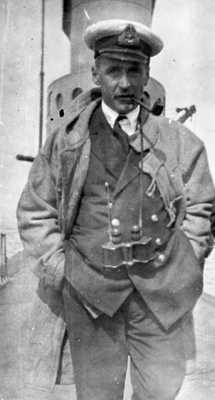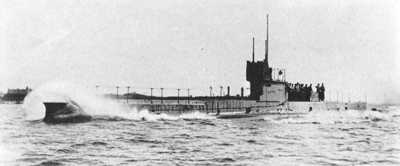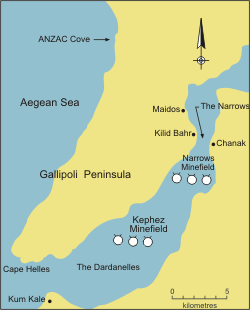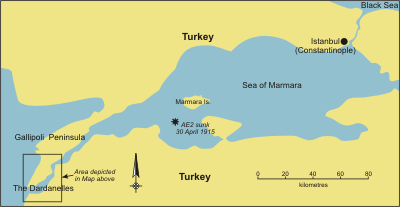Just before the ANZACs landed at Gallipoli on the morning of 25 April 1915 an Australian submarine, the AE2 set out on an historic journey. Its mission was to force a passage up the treacherous Dardanelles Strait into the Sea of Marmara, and then, in the words of the Chief of Staff, 'Generally run amok.' Such an extraordinary order required an extraordinary captain and luckily the AE2 had such a captain, Lieutenant Commander Henry Hugh Gordon Dacre Stoker -- an Irishman.

Lieutenant Commander Henry Hugh Gordon Dacre Stoker. Photo courtesy Fred and Elizabeth Brenchley.
Henry Hugh Gordon Dacre Stoker, the second son of a physician, was born in Dublin on 2 February 1885. At the age of 12 he went to England to enter a school which specialised in training boys to pass the entrance examination for the Royal Navy, which he eventually joined at 15. After three years service aboard HMS Implacable, he applied to join the fledgling submarine service. Within two years he was promoted to lieutenant and obtained his first command -- HM Submarine A10.
By 1914 he was an experienced submariner and was chosen to command AE2, one of the two new submarines built at Barrow-in-Furness for the Australian Navy. Despite the fact that the rudimentary submarines of that era had never managed to sail more than 200 miles without breaking down, the intrepid Stoker and his mixed crew of Australian and English ratings -- in company with the other Australian submarine AE1 -- set sail for Australia on 2 March 1914. On 24 May 1914, after an incredible voyage of 83 days of which 60 were at sea, the two submarines made their entrance into Sydney Harbour. They were the first submarines to travel such a distance.
Soon after their arrival in Australia, the AE1 and AE2 were sent north to assist in the Australian occupation of German New Guinea. AE1 was mysteriously lost with all hands during the mission. However, Stoker and AE2 successfully returned to Australia. Immediately on his return, Stoker in his flamboyant style, bailed up the Australian Defence Minister -- behind the Speaker's chair in the House of Representatives -- and talked him into sending the AE2 back to Europe to assist in the European war. Not content with doing the historic England-Australia voyage once, Stoker and the AE2 set off back to Europe in December 1914. However, he only got as far as the Mediterranean before being ordered to join the British fleet at Tenedos Island and patrol the entrance to the Dardanelles. It was the start of the Gallipoli Campaign.

Like to copy this image? Please click here first
AWM P01075.043. Port bow view of HMA Submarine AE2 on arrival at Portsmouth, England, to prepare for the voyage to Australia.
According to Stoker, in his gripping autobiography Straws in the Wind, he quickly 'formed the opinion that an attempt to dive a submarine right through the Dardanelles Strait and into the Sea of Marmara held sufficient chance of success to justify the attempt being made'. The psychological advantage of entering the Sea of Marmara and thereby threatening Constantinople from the sea would be enormous.
However, the difficulties were tremendous. The Strait was thirty-five miles long with a continuous current running at five knots back into the Mediterranean. The whole area was heavily mined, and although a submarine could dive under the mines with its periscope submerged it had to remain at periscope depth in order to navigate the narrow Strait. If it cleared the minefield, the submarine would be in narrow waters, completely controlled by the Turkish Navy.
Despite the fact that the British submarine, the E15, had just been lost attempting to force the Strait, Stoker badgered the Admiralty with letters requesting an opportunity to make an attempt. Finally Stoker was received by the Chief of Staff, Commodore Roger Keyes and told he would be permitted to try. Admiral Sir John De Robeck, the Vice-Admiral of the Mediterranean Fleet told Stoker that 'if you succeed there is no calculating the result it will cause, and it may well be that you have done more to finish the war than any other act accomplished'. As Michael White remarked in his book, Australian Submarines, 'these were heady words for any man to have addressed to him, let alone one such as Stoker who had already shown outstanding qualities of enterprise and daring'.
At 2.30 am on the morning of 25 April 1915, Stoker weighed anchor and set out on the attempt to run the Dardanelles Strait, which would forever assure him of a place in Australian naval history. His plan was basically simple -- travel as far as possible on the surface to conserve his limited battery power, and dive at daylight or when he reached the minefields.


The map at the top is a magnified section of the marked rectangular section of the map at bottom.
The night of 25 April was a beautiful dark and calm night and the AE2 proceeded along at seven knots in the centre of the Strait. Suddenly they were spotted by the searchlight at Kephez and shells began to rain down. Stoker quickly submerged and passed a harrowing hour slowly creeping under the minefield. He could hear the mooring wires of the mines scraping the sides of AE2. 'Choose a wrong moment to rise for observation through the periscope and you choose a moment to hit a mine -- so choose as few of these moments as possible', Stoker dryly observed in Straws in the Wind. Rising twice in the minefield, Stoker realised he was travelling faster than he had anticipated. When he rose for the third time, he was pleased to find himself through the minefield and only three hundred yards below the famous Narrows.

Artist's impression of AE2's Dardanelles journey. (Artist unknown; Royal Naval Submarine Museum, Gosport, UK). Photo courtesy Fred and Elizabeth Brenchley.
The Turks were now well aware of the AE2's presence and soon a small cruiser and a number of destroyers were attacking the submarine. Stoker fired a torpedo which missed the cruiser but it struck and damaged one of the destroyers. Submerged and trying to escape the destroyers' attempts to ram him, Stoker hit the bottom hard and slid up to a depth of 10 feet, right under the guns of a shore-based fort. The position was perilous. AE2 was fast aground with almost half of its structure out of the water. Stoker described it 'as unpleasant as it well could be'. Luckily they were so close to the fort that the guns could not be depressed enough to hit the submarine and after a short time the efforts of the crew to refloat AE2were successful. One of the crew recorded in his diary:
During all this the Captain remained extremely cool, for all depended on him at this stage. It is due to his coolness that I am now writing this account. Nobody knows what a terrible strain it is on the nerves to undergo anything like this, especially the Captain, as all depends on him.
Stoker and his crew resumed their journey pursued by dozens of Turkish warships. Antisubmarine warfare was in its infancy and the only way the Turks could attack the AE2 was by trying to ram her. As long as AE2 could stay submerged, it was relatively safe. However navigating the narrow strait was impossible without frequently coming up to periscope depth to take a sighting. Whenever they lifted the periscope, the Turkish ships attempted to ram. Stoker decided to run the AE2 on to an underwater bank and sit on the bottom until dark.
For sixteen hours the dauntless Stoker and his crew sat in darkness and silence at a depth of 80 feet. When they finally rose to the surface they found themselves about half a mile from the shore in a bay above Nagara Point -- the worst of their journey was now behind them. Stoker sent a radio message back to the fleet but never received an answer, and consequently was unsure if the message had been received. He was to learn much later that the message was indeed received, and that his message was to change the course of history.
The Allied landings on the Gallipoli peninsular had been met with fierce resistance. From their position on the beach General Bridges and his staff were alarmed at the ANZACs position and requested that they be withdrawn back to the fleet. Just as Stoker's message was received, a midnight conference was being held on the flagship Queen Elizabeth to decide whether to withdraw the troops off the peninsular.
A friend of Stoker's, Lieutenant Commander C G Brodie, ignored requests to keep quiet and read to the conference Stoker's message heralding AE2's success. 'The psychological impact at that precise time was momentous', Michael White said in Australian Submarines. It will never be known if they were actually going to pull the troops off Gallipoli, but after Stoker's message was read Hamilton sent his famous 'dig, dig, dig' message to the Australians:
Your news is indeed serious. But there is nothing for it but to dig yourselves right in and stick it out. It would take at least two days to re-embark you, as Admiral Thursby will explain to you. Meanwhile the Australian submarine has got up through the Narrows and has torpedoed a gunboat at Chanak. P S You have got through the difficult business. Now you have only to dig, dig, dig, until you are safe.
The news of the AE2's achievement spread to the Diggers clinging to the Gallipoli cliffs and lifted their morale. A notice was stuck on a shell-shattered stump on the hillside:
'Australian sub AE2 just through the Dardanelles. Advance Australia'.
Meanwhile Stoker was pressing on in AE2 towards the Sea of Marmara. He encountered two Turkish warships and fired a torpedo at the largest but was unsuccessful. After spending the night of 25-26 April on the surface, AE2 finally entered the Sea of Marmara early in the morning of 26 April. Their mission now was to prevent Turkish ships transporting troops across the Marmara to Gallipoli.
Spotting a likely target Stoker fired one of his precious torpedoes but again missed. He spent the remainder of the day on the surface sailing among fishing boats and doing all he could to broadcast the arrival of an allied submarine in the Marmara. After dark, Stoker again attempted to contact the fleet by wireless but was forced to dive constantly to escape Turkish patrol vessels.
At dawn Stoker resumed the offensive and fired a torpedo at a ship which was accompanied by two destroyers. The torpedo's engine failed to start and Stoker just managed to avoid being rammed by one of the destroyers. No other ships were sighted for the rest of the day which shows that the AE2's presence was curtailing Turkish ship movements.
By the morning of the 29th, Stoker was still sailing in the Sea of Marmara and harassing any Turkish ship he could find. However, he was now down to one torpedo which he decided to keep in reserve. His plan was to sail around, be as provocative as possible, and try to fool the Turks into believing that more than one submarine had made it to the Sea.
Early on the evening of the 29th, while sailing towards Marmara Island, the crew ofAE2 was surprised to encounter another submarine. It was the British submarineE14 under the command of Captain Boyle, which had been dispatched after the Admiralty heard of Stoker's successful passage up the Strait. Boyle asked Stoker what he planned to do the next day. It had been Stoker's intention to sail to Constantinople but Boyle, being the senior officer, overruled that plan and arranged to rendezvous with Stoker the next morning. This decision would seal the fate ofAE2 and her gallant crew.
When Stoker surfaced at the rendezvous at 10am, he observed a torpedo boat and immediately dived. For some unaccountable reason the AE2 suddenly went out of control and began rapidly to rise. The submarine shot to the surface about 100 yards from the torpedo boat which opened fire. Stoker again attempted to dive but the AE2 was out of control and began to plunge into the depths.
Stoker took the prescribed emergency action and arrested the descent, but nowAE2 rushed back towards the surface where it was hit by shells from the attacking boat and was holed in several places. AE2 was doomed. Stoker ordered the submarine scuttled and concentrated on saving the lives of his men.
All the crew survived and were taken prisoner, and together with Stoker spent the next three-and-a-half years as 'guests' of the Turks. Stoker escaped twice but was recaptured and endured numerous hardships in Turkish prisons.
After repatriation he was awarded the Distinguished Service Order and was offered the command of a cruiser but chose to leave the Navy for a career on the stage. He appeared in a number of plays, films and television dramas. His contemporaries included Sir Laurence Olivier and Sir John Mills.
When the Second World War broke out Stoker rejoined the Navy, and served for the duration.
The larger-than-life Stoker died on his 81st birthday in 1966.
While Australia takes justifiable pride in the heroism of the ANZACs, and Simpson and his donkey are part of the nation's folklore, little is known of the dauntless Henry Hugh Gordon Dacre Stoker. Yet this man sailed a submarine around the world, and pulled off one of the most daring exploits in naval history. His achievements deserve to be placed firmly in history; he caused the Turks to abandon attempts to reinforce Gallipoli by sea, and forced them to use a much more hazardous land route. His success changed the whole course of the Gallipoli Campaign. As searchers now successfully have located the sunken hull of AE2, it's time that the intrepid Stoker and his crew were awarded their place in Australian history.
References
Michael W D White, Australian Submarines: A History, Australian Government Publishing Service, Canberra, 1992. Fred and Elizabeth Brenchley, Stoker's Submarine, HarperCollins, Sydney, 2001. H H G D Stoker, Straws in the Wind, Herbert Jenkins, London, 1925.
I wish to express my thanks to Primrose Stoker, Stoker's niece, who supplied me with many details of Stoker's life.





